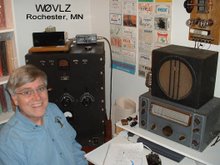Ross Hull's August 1928 QST article, "Overhauling the Transmitter for 1929", is a great article for anyone interested in putting a late 20s/early 30s self excited oscillator on the air. This includes the Hartley, Colpitts, TPTG and TNT transmitters used in the AWA Bruce Kelley 1929 CW Party. In the words of QST, this "is, we feel, one of the most important articles ever published for the radio amateur. Let every amateur study it most carefully, and apply its information, for it contains salvation for 1929." It can be found by searching the QST magazine article archives at http://www.arrl.org/.
Ross Hull's major point is that the poor signals legal in 1928 will no longer be acceptable in 1929. He further states that the main problem is the "men pushing the keys". How 1929 transmitters are tuned up makes a big difference in signal quality. The actual transmitter required to meet 1929 standards can be fairly simple. To prove his point he describes the one I built, a "simple -- in fact crude -- rig...capable of performing quite creditably". He even goes on to say that he anticipates some "raspberries" over the crudity of his simple transmitter.
Transmitter features helping signal quality include a heavy tank coil/circuit, mounting the tube so tuned circuit heating is minimized and high tuning capacity/low inductance. Ross Hull emphasizes that the inexpensive hardware features he's listed combined with proper tuning over come lots of the frequency shift introduced by marginally filtered or unregulated B+ supplies, antennas swaying in the wind and components heating up. Simple 1929 transmitters don't need to "splutter, wobble, creep and rattle across great slices of the bands".
In fairness, I still find that moderate winds causing antenna sway does introduce some FMing, but my signal is acceptable. Hull, in fact, states that a DC (T9) note is extremely uncommon and rather unpleasant. He much prefers a more "musical note" that we might rate T8. Given proper tuning that's about where mine is: a sweet, musical, T8 signal. Also keep in mind that this transmitter design does not address other "creature comforts". It is microphonic requiring it to be placed on a table separate from the operating position, hand capacity is a problem and bandspread, such that there is, is barely adequate for getting on frequency. These could be addressed in a more expensive design but their solution is not required in order to archive "any reasonable [signal quality] standard set for 1929".
Sunday, November 15, 2009
Subscribe to:
Post Comments (Atom)

No comments:
Post a Comment